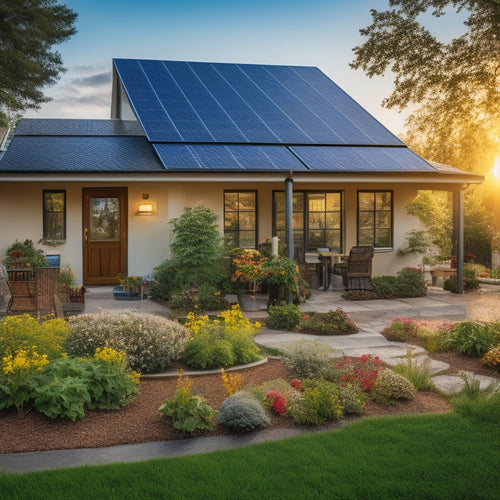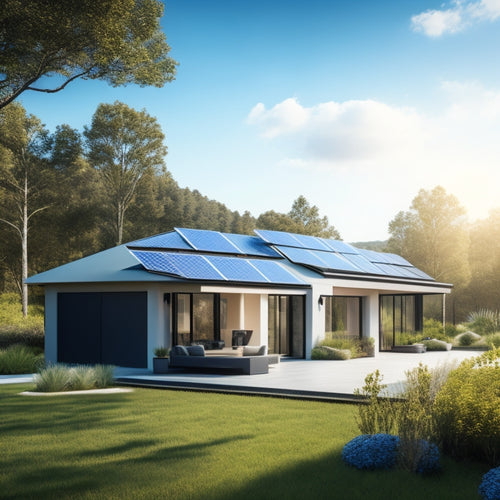
Best Home Energy Management Systems
Share
The best Home Energy Management Systems (HEMS) provide you with real-time monitoring of energy consumption, helping you identify high-usage appliances and optimize your energy habits. Look for systems that integrate smart thermostats, allowing precise control of heating and cooling based on your routines, leading to significant savings. User-friendly interfaces and mobile app functionalities enhance convenience, enabling remote adjustments and automated control of various appliances. Features like customizable alerts and scheduling capabilities allow you to manage costs effectively while gaining understanding into your energy usage patterns. Exploring these systems further will reveal how they can change your energy efficiency.
What You Need to Know
- Look for systems with real-time energy monitoring to track consumption patterns and identify high-energy appliances for better management.
- Choose HEMS that integrate smart thermostats for optimized climate control and reduced energy usage during off-peak hours.
- Select solutions with smart device integration, allowing remote control and automation of appliances for improved energy efficiency.
- Ensure the system offers user-friendly interfaces, such as mobile apps and voice control, for convenient energy management and custom alerts.
- Consider systems that provide detailed energy audits to identify inefficiencies and recommend energy-saving strategies effectively.
Cost-Effective Energy Savings
Integrating a smart thermostat into your home energy management system can greatly enhance energy efficiency by optimizing heating and cooling schedules based on your habits.
Additionally, employing smart storage ideas can help streamline your home's organization, allowing for better use of space that can also reduce energy costs.
Coupled with real-time energy monitoring, you gain immediate understanding into your energy consumption patterns, allowing for informed decisions to reduce waste.
Smart Thermostat Integration
Smart thermostat integration offers a powerful solution for homeowners seeking cost-effective energy savings. By utilizing advanced thermostat features, you can optimize your home's heating and cooling systems, leading to significant reductions in energy consumption.
These smart devices learn your schedule and preferences, adjusting temperatures automatically to guarantee maximum comfort while minimizing waste. Additionally, when coupled with energy-efficient appliances and systems, smart thermostats can further enhance overall energy management, which is essential for households considering evaluating energy needs.
One of the key benefits of smart thermostats is their ability to provide precise control over your home's climate. You can set different temperatures for various times of the day, allowing for energy efficiency without sacrificing comfort.
For example, you can program your thermostat to lower the temperature during the night or when you're away, reducing energy usage when it's least needed.
Moreover, many smart thermostats offer remote access via mobile apps, enabling you to make adjustments while you're on the go. This feature adds a layer of convenience that enables you to take control of your energy consumption.
With these capabilities, integrating a smart thermostat into your home energy management system not only supports your desire for freedom but also results in tangible energy savings, making it a wise investment for the future.
Real-Time Energy Monitoring
Effective energy management goes beyond smart thermostat integration by incorporating real-time energy monitoring. This technology allows you to track your home's energy consumption patterns as they occur, providing immediate knowledge into your energy efficiency.
With a real-time monitoring system, you can identify which devices consume the most power and adjust your usage accordingly. Additionally, integrating renewable energy sources with your monitoring system can enhance your home's sustainability and reduce reliance on the grid, contributing to energy cost savings.
By visualizing your energy data, you gain the freedom to make informed decisions about your habits. For instance, if you notice that your HVAC system is running more than necessary during peak hours, you can take action to minimize its usage, potentially reducing your utility bills.
Furthermore, these systems often provide alerts or recommendations customized to your consumption patterns, helping you optimize your energy use without sacrificing comfort.
Real-time energy monitoring also promotes accountability. You're enabled to set goals for reducing energy waste, which leads to a more sustainable lifestyle. As you become more aware of your energy consumption, you can implement changes that not only save money but also contribute positively to the environment.
In a world where energy efficiency is increasingly essential, real-time monitoring is your gateway to effective energy management.
Enhanced Energy Monitoring Capabilities
To optimize your energy consumption, enhanced energy monitoring capabilities provide real-time data tracking that allows you to instantly assess your usage patterns.
By utilizing space-saving solutions for efficient organization, you can also reduce energy waste by keeping your home well-organized and clutter-free.
By analyzing historical usage observations, you can identify trends and anomalies that may affect your energy efficiency.
These tools enable you to make informed decisions, ultimately leading to smarter energy management in your home.
Real-Time Data Tracking
Precision in energy management relies heavily on real-time data tracking, which enables you to monitor your energy consumption with unparalleled accuracy. By integrating advanced sensors and smart technology, real-time tracking provides immediate revelations into your energy usage patterns.
These revelations are essential for making informed decisions that can greatly reduce your energy bills and carbon footprint. Additionally, real-time energy monitoring identifies inefficiencies, allowing you to optimize your energy consumption effectively.
With strong energy consumption analytics, you can identify which appliances consume the most energy and when. This data enables you to optimize usage and potentially shift demand to off-peak times, enhancing your overall energy efficiency.
In addition, real-time tracking facilitates predictive usage modeling, allowing you to forecast future energy needs based on historical trends and current consumption patterns.
This proactive approach not only helps you avoid energy waste but also promotes a sustainable lifestyle, granting you the freedom to control your energy usage effectively.
The ability to adjust your habits in real-time means you're not merely reacting to past usage but actively managing your energy consumption for the future.
With these tools at your disposal, you can take charge of your energy environment and enjoy the benefits of a more efficient home.
Historical Usage Insights
Your home's historical usage observations play an essential role in enhancing energy monitoring capabilities. By analyzing historical data, you can uncover critical usage patterns that inform your energy management strategy. This data typically includes past consumption rates, peak usage times, and seasonal fluctuations, allowing you to identify opportunities for optimization.
When you evaluate these historical trends, you'll gain understanding into which appliances consume the most energy and when they operate most efficiently. This knowledge enables you to make informed decisions about energy usage, such as scheduling high-consumption tasks during off-peak hours. Additionally, understanding historical usage patterns can help you set realistic energy-saving goals, tailoring your approach to your unique consumption behavior.
Moreover, integrating historical data with real-time monitoring can greatly enhance your energy management system. You'll be able to track the effectiveness of your energy-saving measures and adjust them as needed.
This analytical approach not only leads to cost savings but also contributes to a more sustainable lifestyle. Ultimately, leveraging historical usage knowledge equips you with the freedom to optimize your energy consumption effectively, ensuring you maintain control over your energy expenditures.
Key System Functionalities
In a Home Energy Management System, real-time energy monitoring plays an essential role in optimizing your energy consumption.
By integrating smart devices, you can automate and control energy usage more efficiently, ultimately reducing costs.
Understanding these functionalities allows you to make informed decisions that enhance your home's energy performance.
Real-Time Energy Monitoring
Utilizing advanced sensors and software algorithms, real-time energy monitoring systems provide homeowners with immediate observations into their energy consumption patterns. These systems track usage in real time, enabling you to identify which appliances or devices are consuming the most power. With this precise data, you can make informed decisions about your energy habits, ultimately leading to cost savings and enhanced energy efficiency.
Moreover, real-time monitoring allows you to set specific benchmarks for your energy consumption. By analyzing your usage patterns, you can pinpoint peak consumption times and assess how changes in behavior affect your overall energy profile. This proactive approach gives you the ability to adjust your habits, whether it's turning off devices when they're not in use or investing in energy-efficient alternatives.
Additionally, many systems offer customizable alerts, notifying you when your energy consumption exceeds predefined limits. This feature not only keeps you aware of your usage but also encourages responsible energy management.
Fundamentally, real-time energy monitoring alters how you interact with your home's energy system, providing you with the freedom to optimize your consumption and reduce unnecessary expenses.
Smart Device Integration
Real-time energy monitoring lays the groundwork for effective smart device integration, which enhances the functionality of home energy management systems. By ensuring smart device compatibility, you can seamlessly connect various appliances and systems, enabling automated energy management that optimizes your energy consumption.
Here's a quick overview of key functionalities that smart device integration can offer:
| Functionality | Description |
|---|---|
| Remote Control | Manage devices from anywhere via apps. |
| Scheduling | Set timers to use energy during off-peak hours. |
| Energy Analysis | Examine consumption patterns for efficiency. |
| Alerts & Notifications | Receive real-time updates on energy usage. |
Integrating smart devices not only simplifies your life but also enables you to make informed decisions regarding your energy consumption. With automated energy management, you can reduce waste and control costs, giving you the freedom to enjoy your home without the burden of high energy bills. Embracing these technologies allows you to take charge of your energy usage, leading to a sustainable and efficient lifestyle.
Assess Your Home's Energy Usage
To effectively assess your home's energy usage, start by monitoring consumption trends over time.
This data will help you identify which appliances are consuming the most energy, allowing for targeted adjustments.
Monitor Energy Consumption Trends
Monitoring energy consumption trends is vital for understanding and optimizing your home's energy usage. By analyzing energy consumption patterns, you can pinpoint when and how energy is being employed throughout the year. This data helps you identify seasonal usage variations, which often impact your overall energy costs.
Employing a home energy management system allows you to track real-time energy data, giving you perceptions into daily, weekly, and monthly trends. You'll begin to notice peak usage times, revealing when your household consumes the most energy. This information is important for making informed decisions about energy-saving strategies and behavioral changes.
For instance, if you find out that energy usage spikes during certain months, you can adjust your habits accordingly. You might schedule high-energy tasks, like laundry or dishwashing, during off-peak hours to reduce costs.
Additionally, recognizing consistent energy consumption patterns can help you identify potential inefficiencies in your home, guiding you toward necessary upgrades or adjustments.
Identify High-Usage Appliances
Identifying high-usage appliances is vital for evaluating your home's energy consumption effectively. Start with an energy audit, which involves reviewing each appliance's energy consumption over time. By tracking usage patterns, you can pinpoint which devices are draining your resources the most.
Focus on appliance ratings, as these provide significant data regarding energy efficiency. Look for the Energy Star label or similar certifications that indicate a product's performance. High-rated appliances often consume less energy than their lower-rated counterparts, so upgrading can lead to substantial savings.
Consider using smart plugs or energy monitors to gather real-time data on specific appliances. This technology allows you to measure wattage and identify usage spikes, giving you a clearer overview of your energy profile.
Once you've identified high-usage appliances, you can strategize on reducing consumption. Whether it's adjusting usage times, replacing older models with energy-efficient versions, or implementing smart home systems, you'll enable yourself to take control of your energy costs.
User-Friendly Interface
When evaluating a Home Energy Management System, intuitive control options greatly enhance your user experience.
You're likely to prioritize interfaces that allow you to easily maneuver through settings and monitor energy consumption in real-time.
A well-designed interface not only simplifies operation but also promotes effective energy management through quick access to essential features.
Intuitive Control Options
A user-friendly interface is essential for the effective operation of Home Energy Management Systems (HEMS). When you can easily maneuver and control your energy usage, you gain the freedom to make informed decisions. Intuitive control options, such as voice control and mobile app functionalities, enhance your experience and enable you to manage your energy consumption efficiently.
Consider the following features that contribute to an intuitive interface:
| Feature | Benefits | Example Use Case |
|---|---|---|
| Voice Control | Hands-free operation | Adjusting settings while cooking |
| Mobile App | Real-time monitoring and control | Managing energy usage on-the-go |
| Custom Alerts | Notifications for energy spikes | Staying informed about usage patterns |
With these options, you can quickly adjust settings or receive updates about your home's energy performance. A seamless integration of these features creates an environment where you feel enabled to optimize your energy use. Fundamentally, an intuitive control system not only simplifies your interaction with energy management but also aligns with your desire for convenience and autonomy in your daily life.
Frequently Asked Questions
What Are the Environmental Benefits of Home Energy Management Systems?
Home energy management systems enhance energy efficiency, reducing your carbon footprint. By optimizing your energy usage, you're not just saving money; you're actively contributing to a healthier environment, promoting sustainability, and embracing your freedom to live responsibly.
Can These Systems Integrate With Renewable Energy Sources?
"Don't put all your eggs in one basket." These systems often excel in system compatibility, enabling seamless renewable integration. By tapping into solar or wind sources, you maximize efficiency and enhance your energy independence.
How Do I Maintain My Home Energy Management System?
To maintain your home energy management system, regularly check for system updates and conduct performance monitoring. This guarantees peak efficiency, identifies issues early, and allows you to make informed adjustments, giving you greater control over your energy usage.
Are There Any Rebates for Installing These Systems?
Yes, you can find installation incentives for energy management systems. Many utility companies and government programs offer rebates that help offset costs, enhancing your energy savings while promoting sustainable practices in your home.
Will My Home Energy Management System Work With Smart Appliances?
Can your home energy management system integrate with smart appliances? Absolutely! With smart appliance compatibility, you'll gain real-time energy usage monitoring, allowing you to optimize efficiency and reduce costs. Your freedom and convenience await.
Explore More
By investing in a home energy management system, you can not only cut costs but also gain unparalleled understanding into your energy usage. Did you know that households can save up to 30% on their energy bills with effective monitoring and management? With enhanced capabilities and user-friendly interfaces, these systems enable you to track energy consumption in real time, allowing you to make informed decisions that optimize efficiency and reduce waste. Accept technology to change your energy habits today.
Related Posts
-

How to Achieve Energy Independence at Home
To achieve energy independence at home, start by investing in renewable energy sources like solar panels, wind turbin...
-

Sustainable Home Design for Reduced Carbon Footprint
Sustainable home design is your pathway to a smaller carbon footprint and a healthier living space. By incorporating ...
-

Eco-Friendly Energy Storage Systems for Houses
Eco-friendly energy storage systems for your house let you capture and use renewable energy efficiently. You can choo...


